2019 saw a great deal of change and lots of savings for my clients. These employers were finally looking at legitimate ways to lower their healthcare costs, rather than shift costs to employees through higher deductibles and contributions. As they have done for so many years in the past, these methods are no longer working.
The employers I’ve met with in 2019 are those who were serious about challenging the status quo of health insurance company programs, utilizing the same traditional methods and plans, and have now implemented a variety of innovative and proven methods to lower their health care costs for the long term.
These include a variety of approaches including, metric based pricing, specialty drug programs, Canadian import plans for drugs, direct contracting with providers, and moving from fully insured to an unbundled self-funded plan, to name a few. These methods along with paying brokers and consultants on a fee only basis (rather than on a commission as a percentage of ever-increasing premiums) are creating long-term, positive impacts on their bottom line and greater satisfaction with employees.
Case in point – a small nonprofit business with approximately 75 employees who had a traditional fully insured plan with United Health Care. After numerous discussions and financial evaluations and comparisons, the group decided to move ahead with an unbundled partially self funded plan and metric based pricing. They’re guaranteed savings of over $240,000 a year ($3,238 per employee per year) and will create a meaningful financial impact for their organization.
Another group – a utility company was able to save for over $4,000 per employee per year and kept the same benefits they had with Anthem.
Yet another large international electronics firm has projected savings of over $6.3 million for their 1,500 employees. This represents a $4,200 savings opportunity for them as well utilizing a similar approach to re-design how they have purchased health care and health insurance in the past.
Still another employer – an electrical contractor was able to save over $158,000 below their aggregate attachment point (23.5% loss ratio) and was able to give their employees a refund check towards their contributions.
All of these cases represent an exercise of supreme financial fiduciary responsibility, whether they are a not-profit, public entity, or private employer. These employers are taking charge of their programs for their businesses and their employees, rather than giving the control to insurance companies.
These companies will achieve a long-term financial impact and savings for their employees, and give them the opportunity to provide employees with meaningful wage increases or bonuses at the end of the year, should they desire to do so.
If you want to learn how you and your company can take advantage of a new approach and design of your health plan which results in compelling savings, you can reach me at 970.349.7707 or [email protected]
F rank Stichter has been a trusted health insurance advisor and consultant to businesses for 40 years and specializes in self funded health plans. He is an Accredited Health Rosetta Benefits Advisor and is also the author of his book “You Don’t Know What You Don’t Know – Secrets Revealed From A Health Insurance Industry Insider.”
rank Stichter has been a trusted health insurance advisor and consultant to businesses for 40 years and specializes in self funded health plans. He is an Accredited Health Rosetta Benefits Advisor and is also the author of his book “You Don’t Know What You Don’t Know – Secrets Revealed From A Health Insurance Industry Insider.”

